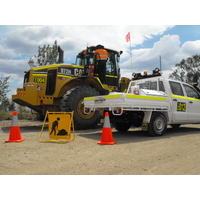
Australia has established specific safety guidelines for the use of mobile and transportable equipment in mining operations, with a strong emphasis on risk management, equipment standards, and clear signage responsibilities.
The principal reference is the "MDG 15: Guideline for Mobile and Transportable Plant for Use at Mines and Petroleum Sites," issued by the NSW Resources Regulator. While not mandatory, MDG 15 highlights critical risk areas, referencing past incidents and providing recommended controls for hazards associated with mobile and transportable plant. MDG 15 has been revised at least six times since its initial publication in 1992, with the most recent version released in April 2020. The guideline applies to:
- Surface mines (excluding underground coal mines)
- Surface parts of underground mines
- Underground metalliferous mines
- Petroleum sites
Mobile plant includes self-propelled machinery such as excavators, dump trucks, loaders, graders, bulldozers, and similar equipment. Transportable plant refers to trailer-mounted or track-mounted equipment that requires towing, such as pumps, welders, mobile crushers, and substations.
.jpg)
Key Safety Responsibilities
1. Risk Management and Assessment
- Conduct thorough risk assessments for all mobile and transportable plant, considering hazards such as fire, unplanned movement, safe access/egress, vibration, isolation, and human factors.
- Designers must perform a design hazard analysis to identify foreseeable hazards and implement fit-for-purpose controls to eliminate or minimize risks.
- The risk assessment must cover all lifecycle stages: design, manufacture, supply, acquisition, introduction, use, maintenance, modification, and disposal.
2. Safety Systems and Controls
- Ensure safety-critical systems are in place, such as brakes, guards, proximity detection, and fire suppression.
- Install warning devices for situations like exceeding safe loads, unsafe grades, roll-over risks, over-speed, and operator fatigue.
- Provide clear documentation on plant operating limits and capacities, including maximum loads, grades, and speeds.
3. Compliance with WHS Laws
- All mines must comply with Work Health and Safety (WHS) legislation, which mandates hazard identification, risk management, and incident reporting.
- Each mine must have a tailored safety plan addressing its unique risks, updated as conditions or equipment change.
4. Personal Protective Equipment (PPE)
- Mines are legally required to provide PPE, including hard hats, steel-toe boots, high-visibility vests, safety glasses, gloves, and hearing protection.
- Adequate lighting, such as cap lamps, is essential for visibility and hazard avoidance, especially underground.
5. Emergency Preparedness and Training
- Mines must have documented emergency response plans, including evacuation routes, safety rooms, fire/flood procedures, and communication protocols.
- Regular emergency drills and comprehensive worker training (hazard identification, equipment use, emergency response) are mandatory.
Key Signage Responsibilities
1. Warning and Instructional Signage
- Clearly display warning signs for all identified hazards, including areas with moving machinery, restricted access, and hazardous materials.
- Signage must be visible, durable, and in line with Australian standards.
2. Emergency and Escape Signage
- Mark all emergency exits, escape routes, and safety rooms with clear, illuminated signage.
- Escape plans should be posted in prominent locations, with pathways kept unobstructed at all times.
3. Equipment-Specific Signage
- Attach signage to equipment indicating safe operating limits (e.g., load capacities, speed limits, grade limitations).
- Display instructions for safe use, maintenance, and emergency shutdown procedures directly on or near the equipment.
Ongoing Compliance
- Mines must conduct daily safety inspections, monitoring air quality, ground stability, and the condition of equipment and signage.
Regularly review and update safety plans, signage, and training to reflect changes in equipment, operations, or regulations.
Summary Table: Key Safety and Signage Duties
| Duty Area | Key Responsibility |
| Risk Assessment | Identify, assess, and control hazards for all equipment and site conditions |
| Safety Systems | Install and maintain safety-critical features and warning devices |
| PPE | Provide and enforce use of appropriate personal protective equipment |
| Emergency Preparedness | Develop, communicate, and drill emergency response plans |
| Signage | Display clear, compliant warning, instructional, and emergency signage |
| Training | Deliver initial and ongoing safety and equipment training for all workers |
| Inspections & Reporting | Conduct daily checks and report incidents as required by law |
By following these guidelines and responsibilities, Australian mines can maintain compliance with both industry best practices and legal requirements, significantly reducing the risk of incidents and ensuring a safer working environment for all personnel.
If you are looking for any products that are required to assist you in getting up to MDG15 specifications prior to working on a mining site, reach out to the team at Industroquip on 1300 554 192 or browse our range of MDG15 compliance products and mining safety equipment and signage.

Leave a Comment